
The Bath House was built in 1748 for Sir Charles Mordaunt of the nearby Walton Hall mansion, near Stratford-upon-Avon in Warwickshire, England. It is listed at grade II*. [1]

The Bath House was built in 1748 for Sir Charles Mordaunt of the nearby Walton Hall mansion, near Stratford-upon-Avon in Warwickshire, England. It is listed at grade II*. [1]
The Bath House was designed by the architect Sanderson Miller. As well as the bath chamber, the building incorporates an elegant octagonal room above, which was used by bathers to recover after their cold baths. The room is unusually decorated with icicle-like plaster work to the ceilings, and with sea shells set into the plasterwork decorating the walls. The shell decoration was by Mary Delaney. The building fell into disuse after the Second World War, and was subject to considerable vandalism. In 1987 the Landmark Trust leased the building and the trust restored it between 1987 and 1991. As of 2016, the building is used as holiday accommodation. [1] [2]

East Riddlesden Hall is a 17th-century manor house in Keighley, West Yorkshire, England, now owned by the National Trust. The hall was built in 1642 by a wealthy Halifax clothier, James Murgatroyd. The hall is a Grade I listed building. There is a medieval tithebarn in the grounds.
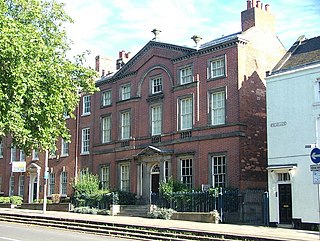
Pickford's House Museum of Georgian Life and Costume is in Derby, England. It is named after architect Joseph Pickford, who built it as his family home in 1770. It was opened as a museum in 1988. The building is Grade I listed.
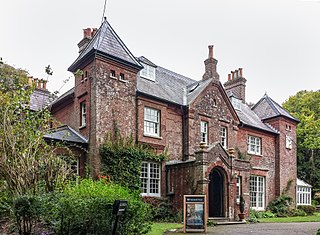
Max Gate is the former home of Thomas Hardy and is located on the outskirts of Dorchester, Dorset, England. It was designed and built by Thomas Hardy for his own use in 1885 and he lived there until his death in 1928. In 1940 it was bequeathed to the National Trust by Hardy's sister and is now open to the public. It was designated as a Grade I listed building on 8 May 1970.
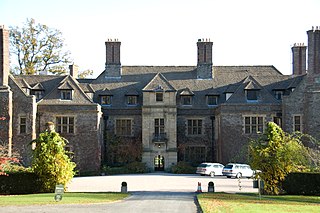
Llangoed Hall is a country house hotel, near the village of Llyswen, in Powys, Mid Wales. It is known for its decoration in Laura Ashley fabrics and styles, and was owned by Sir Bernard Ashley, the widower of the designer. It is a Grade II* listed building.
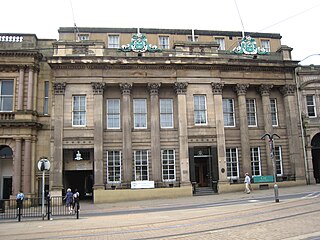
Cutlers' Hall is a Grade II* listed building in Sheffield, England, that is the headquarters of the Company of Cutlers in Hallamshire. It is located on Church Street, opposite Sheffield Cathedral, in Sheffield City Centre.

The Bath Assembly Rooms, designed by John Wood the Younger in 1769, are a set of assembly rooms located in the heart of the World Heritage City of Bath in England which are now open to the public as a visitor attraction. They are designated as a Grade I listed building.
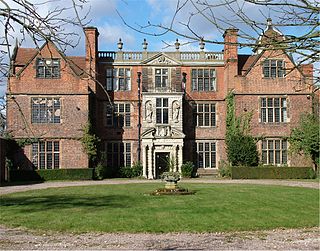
Castle Bromwich Hall is a Jacobean Mansion in the Castle Bromwich area of Birmingham, England. It is a Grade I listed building.

Dyrham Park is a baroque country house in an ancient deer park near the village of Dyrham in South Gloucestershire, England. The house, attached orangery, stable block and accompanying parish church are Grade I listed buildings, while the park is Grade II* listed on the National Register of Historic Parks and Gardens.

Goldney Hall is a self-catered hall of residence in the Clifton area of Bristol, England. It is one of three in the area providing accommodation for students at the University of Bristol and occupies part of the grounds of Goldney House, built in the 18th century and remodelled in the 1860s. The house and several garden features are listed structures, and the garden is designated Grade II* on the Register of Historic Parks and Gardens.

The Theatre Royal in Bath, England, was built in 1805. A Grade II* listed building, it has been described by the Theatres Trust as "One of the most important surviving examples of Georgian theatre architecture". It has a capacity for an audience of around 900.

The Alhambra Theatre is a theatre in Bradford, West Yorkshire, England, named after the Alhambra palace in Granada, Spain, which was the place of residence of the Emir of the Emirate of Granada. It was built in 1913 at a cost of £20,000 for theatre impresario Francis Laidler, and opened on Wednesday 18 March 1914. In 1964, Bradford City Council bought the Alhambra for £78,900 and in 1974, it was designated a Grade II listed building. It underwent extensively refurbishment in 1986. Today it is a receiving house for large-scale touring theatre of all types and the main house seats 1,456.

Farnborough Hall is a country house just inside the borders of Warwickshire, England near to the town of Banbury,. The property has been owned by the National Trust since 1960 when the Holbech family endowed it to them, and is still run and lived in by Geoffrey Holbech's daughter Caroline Beddall and her family. It is a Grade I listed building.

Tatton Hall is a country house in Tatton Park near Knutsford, Cheshire, England. It is designated as a Grade I-listed building and is open to the public.

Swarkestone Hall Pavilion, also known as Swarkestone Stand and The Grandstand, is a 17th-century pavilion 200 metres north of the ruins of Swarkestone Hall, Swarkestone, Derbyshire. It is a Grade I listed building south of Chellaston on the A514.

The Ancient House is a medieval timber-framed building located in Clare in Suffolk, England. It is a Grade I listed building.

The Banqueting House is an 18th-century building, part of the Gibside estate, near Newcastle upon Tyne, England. Its style has been described as "Gothick".
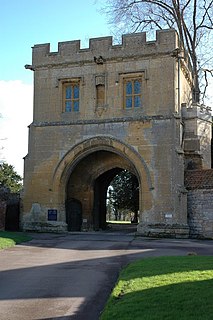
Abbey Gatehouse is a gatehouse building to Tewkesbury Abbey, in Tewkesbury, Gloucestershire, England. It is a Grade I listed building.

Beamsley Hospital is an Almshouse building located near Skipton, in North Yorkshire, and founded in 1593 by the Lady Margaret Russell, the Countess of Cumberland. She had originally intended for the construction of accommodation for 13 poor widows, a Mother and 12 Sisters, but by her death in 1616 only the hospital and chapel building had been completed. Her daughter, Lady Anne Clifford, added the front range which provided accommodation for local widows of little means.

Stowe House in the parish of Kilkhampton in Cornwall, England, UK, was a mansion built in 1679 by John Grenville, 1st Earl of Bath (1628–1701) and demolished in 1739. The Grenville family were for many centuries lords of the manor of Kilkhampton, which they held from the feudal barony of Gloucester, as they did their other principal seat of nearby Bideford in Devon. It is possible that the family's original residence at Kilkhampton was Kilkhampton Castle, of which only the groundworks survive, unusual in that it had a motte with two baileys.

The Izaak Walton Cottage is a seventeenth-century timber framed building in Shallowford, Chebsey, Staffordshire, England. It belonged to the writer Izaak Walton, best known for The Compleat Angler. The building is designated grade II, and is managed as a museum.
| Wikimedia Commons has media related to Bath House, Warwickshire . |
Coordinates: 52°10′20″N1°34′38″W / 52.1722045°N 1.5772355°W